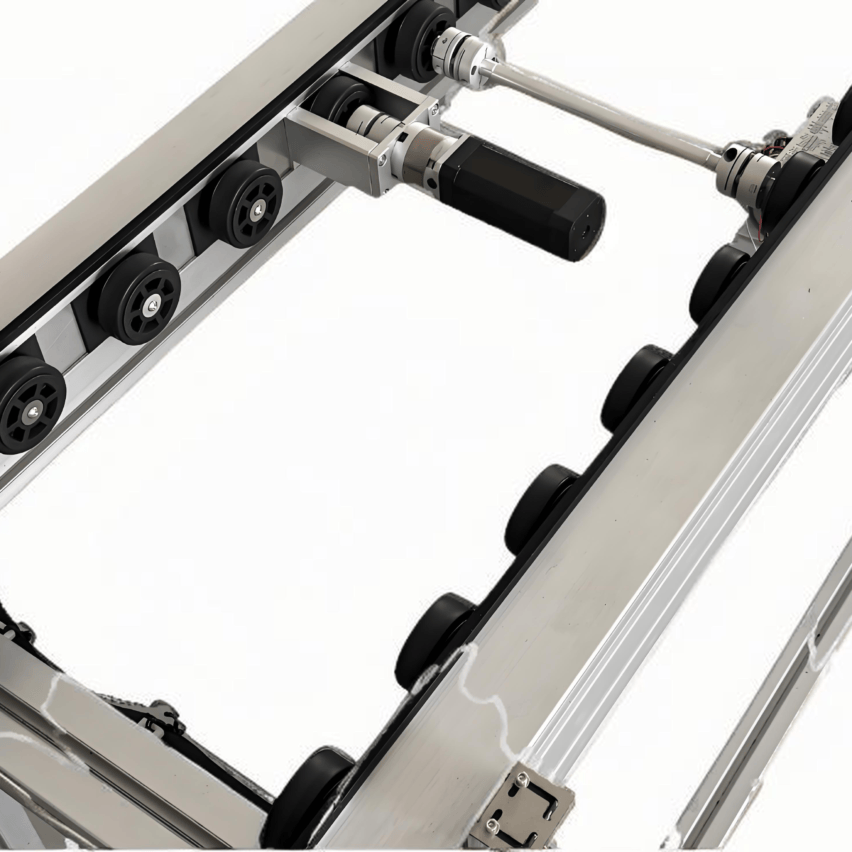"A plant so crowded that even an ant has to walk sideways?" This is not a paragraph, but the status quo that tile factory owners have a daily headache - until theDouble Conveyor System横空出世In the past few years, the space utilisation rate has been raised to 40% with the three-dimensional combination of "air corridor + ground express".
🔄 I. System structure: how do the upper and lower levels play the "relay race"?
Think of an overpass on a road - the lower level runs lorries and the upper level runs trolleys. A double-deck system for tile delivery follows a similar logic:
- The main force at the lower level: Flatbed trucks full of tiles on guide rails heading straight for the processing area, equivalent to thelorry
- upper return path: Empty wagons that have been unloaded are raised to the upper track, like thelight railReturn to the starting point in general silence
- Key points of convergence: Lifting device at both ends asIntelligent LiftThe car can go up in 5 seconds with an empty car and down in 5 seconds with a loaded car.
Ask yourself: how does a flat car enable switching up and down?
A: Take a look.Conveyor steppersThe subtle design of the hook block to catch the flat car → hydraulic jacking → pan positioning → precise drop rail, the whole process is more stable than a crane machine!
📐 Second, Space Magic: How did 40% save?
Why does a traditional single-ply line take up space? Just look at the comparison:
| comparison term | Single-deck conveyor systems | Double Conveyor System |
|---|---|---|
| footprint (of a building, piece of equipment etc) | Requires 200,000-300,000 square metres | Only 60% space required for same capacity |
| Flatbed turnover rate | 1 time/hour | 3 times/hour |
| Channel utilisation | Ground one-way use only | Dual air + ground loop |
The core secret to saving spaceIn:
- vertical stacking: Move return empty cars to the air track and run only loaded cars on the surface
- closed loop flow: Lower tier trucks unload and immediately "take the lift" to upper tier trucks for the return trip
- Intelligent Dispatch:: The system automatically allocates tracks and avoids "blocking junctions" with vehicles.
⚡ iii. Technical highlights: it's not just as simple as saving space!
You thought double-decker systems only stacked? These hidden skills are even more amazing:
- Hydraulic Intelligent LevellingBi-directional hydraulic lever automatically adjusts the tilt angle from 0-15°, making the tiles as smooth as sitting on a magnetic levitation.
- Anti-fall cushioning: 3-metre drop retrofittedRubber Air CushionThe breakage rate was reduced by 82%.
- Multi-track parallel connectionSupports 6-8 conveyor lines in parallel, doubling the production capacity without the fear of "traffic jam".
Ask yourself: will speed be slowed down by multiple layers of transit?
Answer.Flatbed circulation systemLet the conveyance invert 200%! Empty car takes an overhead shortcut to return, 3 times faster than a ground turnaround, get it?
🏭 Fourth, the actual case: real money benefits to speak
Guangdong Guanxing ceramics transformation is a textbook:
- Space utilisation: 24m high three-dimensional warehouse + double-deck conveyor, storage area compressed 40%
- labour costOrder pickers cut from 100 to 20, saving $5 million in annual labour costs.
- Breakage control: RGV long-distance conveying + end buffer, 3 tonnes heavy brick breakage rate <0.3%
furthermoreintelligent linkage--When the stacker picks up the goods, the conveyor line automatically decelerates and aligns; after the tiles are out of the warehouse, the empty pallet is automatically returned to the production line through the elevator→RGV→chain line, and the whole process is like driving on autopilot!
💡 EXCLUSIVE PERSPECTIVE: Saving space is just the beginning...
As a practitioner who has personally tested N factories, I think that theSpatial optimisation is essentially a reconfiguration of the production logic. When the conveyor line goes from a flat surface to a three-dimensional network:
- The equipment relationship has changed: Millimetre accuracy of the fit between stacker cranes and RGVs
- Human-machine collaboration has changed: Workers upgraded from bricklayers to system monitors
- The cost structure has changed: Doubling of combined benefits over three years despite an increase in initial investment of $30%
Bosses who cry "single tier line is enough" are like sticking with flip phones--It's not that you can't afford a smartphone, it's that you can't figure out efficiency.. In manufacturing, after all.Every square metre saved is a real net profit.













